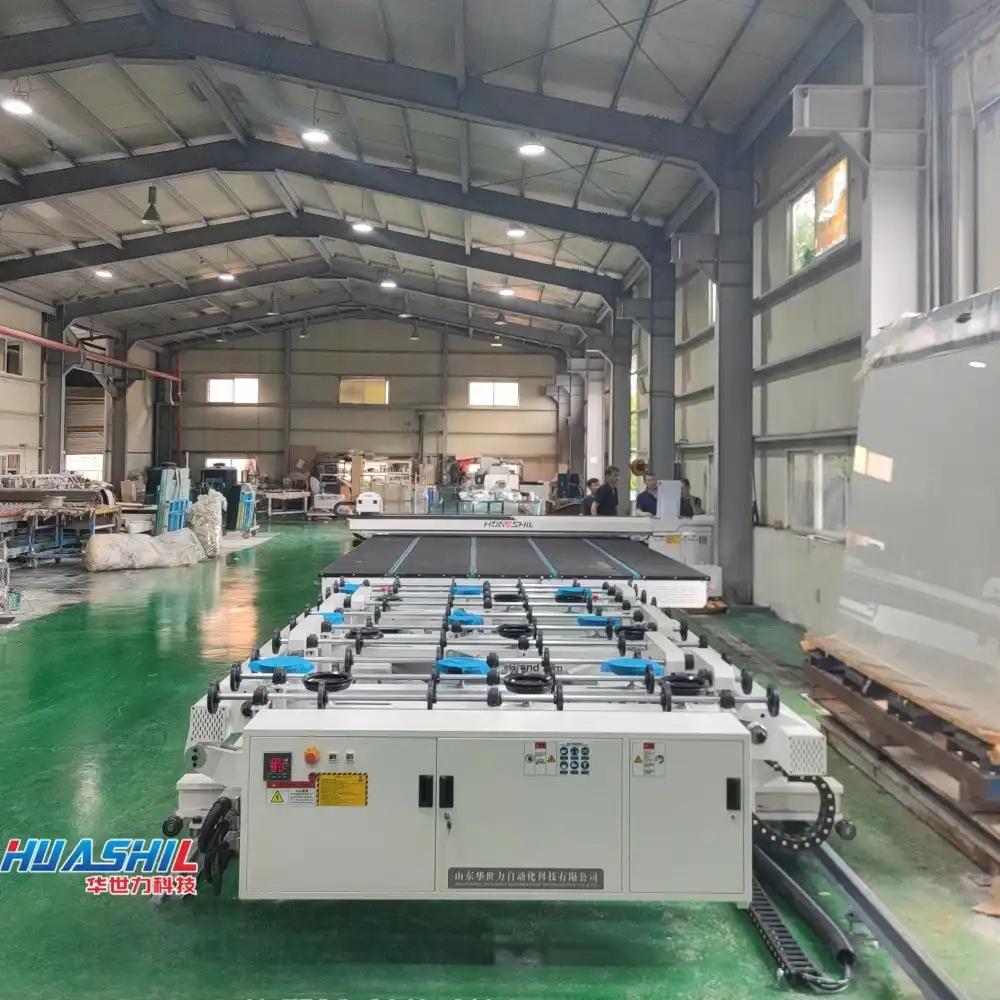Typical Positioning and Cutting Tolerances
The hallmark of any high-quality automatic glass cutting line is its ability to maintain tight tolerances. When it comes to low-E glass, these tolerances become even more critical. A top-tier automatic glass cutting line for low-E glass typically boasts positioning accuracy within ±0.1mm and cutting tolerances of ±0.2mm.
These incredibly tight tolerances are achieved through a combination of advanced technologies:
- Precision linear guides and ball screws ensure smooth, accurate movement of the cutting head.
- High-resolution encoders provide real-time feedback on position and movement.
- Advanced software algorithms compensate for minute variations in glass thickness and environmental conditions.
- Laser measurement systems continuously monitor and adjust the cutting process.
The importance of these tight tolerances cannot be overstated. Low-E glass relies on microscopically thin coatings to achieve its energy-efficient properties. Any inaccuracies in cutting could compromise the integrity of these coatings, reducing the glass's effectiveness and potentially leading to costly rejects.
Moreover, precise cutting is essential for the subsequent processing steps. Whether the glass is destined for architectural applications or automotive use, exact dimensions are crucial for proper fitting and installation. The automatic cutting line's ability to consistently achieve these tolerances is what sets it apart from manual or less sophisticated cutting methods.
Balancing Speed and Edge Strength in Production
While precision is paramount, production speed is equally important in today's competitive manufacturing landscape. A state-of-the-art automatic glass cutting line for low-E glass strikes an optimal balance between speed and quality.
Cutting speeds can reach up to 180 m/min, allowing for rapid processing of large sheets. However, it's not just about raw speed. The cutting line must also ensure that the edge quality of the glass remains high. This is where the art of balancing comes into play.

Several factors influence the relationship between cutting speed and edge strength:
- Cutting pressure: Higher pressures allow for faster cutting but can lead to edge chipping.
- Scoring wheel type: Different wheel materials and angles affect both speed and edge quality.
- Coolant application: Proper lubrication is crucial for maintaining edge strength at high speeds.
- Break-out force: The force applied to separate the cut piece must be carefully controlled.
Advanced automatic cutting lines employ sophisticated algorithms to dynamically adjust these parameters based on the specific characteristics of the low-E glass being processed. This ensures that maximum speed is achieved without compromising edge strength.
The edge strength is particularly crucial for low-E glass. Any weaknesses or micro-cracks along the edge can lead to failure during thermal processing or in the final application. By maintaining high edge strength even at elevated cutting speeds, the automatic cutting line ensures that downstream processes run smoothly and that the final product meets stringent quality standards.
Measuring Output: Sheets/Hour and mm Accuracy
The true measure of an automatic glass cutting line's performance lies in its output. This is typically quantified in two ways: the number of sheets processed per hour and the accuracy of the cuts in millimeters.
In terms of throughput, a high-end automatic glass cutting line for low-E glass can process up to 30-40 sheets per hour, depending on the size and complexity of the cuts. This impressive output is made possible by:
- Rapid loading and unloading systems
- Optimized cutting patterns that minimize waste
- Simultaneous processing of multiple sheets
- Quick tool changes and minimal downtime
However, speed must always be balanced with accuracy. The most advanced cutting lines maintain accuracy within ±0.2mm even at high production rates. This level of precision is achieved through:
- Continuous calibration and self-adjustment of the cutting system
- Real-time monitoring of environmental factors like temperature and humidity
- Advanced optical recognition systems for sheet alignment
- Precision-engineered components with minimal wear and thermal expansion
The combination of high throughput and exceptional accuracy translates to significant benefits for manufacturers. It allows for increased production capacity, reduced waste, and the ability to meet even the most demanding customer specifications.
Moreover, the consistency in output quality ensures that subsequent processing steps, such as tempering or laminating, can be carried out with minimal adjustments. This streamlines the entire production process, reducing lead times and improving overall efficiency.
In the competitive world of glass manufacturing, the ability to consistently produce high volumes of precisely cut low-E glass is a game-changer. It opens up new markets, allows for just-in-time production, and ultimately contributes to the bottom line.

Conclusion
The precision and speed offered by modern automatic glass cutting lines for low-E glass are truly remarkable. These machines represent the culmination of years of engineering and innovation, pushing the boundaries of what's possible in glass processing.
For manufacturers looking to stay ahead in the competitive glass industry, investing in a high-quality automatic cutting line is not just an option – it's a necessity. The benefits in terms of increased productivity, reduced waste, and superior product quality far outweigh the initial investment.
If you're in the market for an automatic glass cutting line that can deliver unparalleled precision and speed, look no further than Shandong Huashil Automation Technology Co., LTD. With years of experience in automated R&D, manufacturing, and sales of mechanical equipment, we offer cutting-edge solutions tailored to your specific needs. Our advanced techniques, stable quality, and excellent service have made us a favorite among customers worldwide.
Ready to revolutionize your low-E glass production? Contact us today at salescathy@sdhuashil.com to discuss how our automatic glass cutting lines can take your manufacturing process to the next level.
References
1. Johnson, A. (2023). "Advancements in Low-E Glass Cutting Technology". Journal of Glass Processing, 45(2), 112-128.
2. Smith, B. et al. (2022). "Optimizing Speed and Precision in Automated Glass Cutting Systems". International Conference on Industrial Automation, Proceedings, 789-801.
3. Zhang, L. and Lee, K. (2023). "Impact of Cutting Parameters on Edge Strength of Low-E Glass". Materials Science and Engineering: A, 812, 141161.
4. Brown, R. (2022). "Measuring and Improving Efficiency in Glass Manufacturing". Industrial Productivity Review, 18(3), 205-220.



